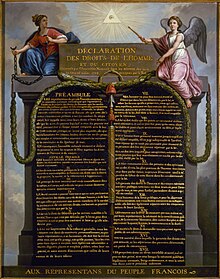Declaration of the Rights of Man and of the Citizen
1789 document of the French Revolution / From Wikipedia, the free encyclopedia
Dear Wikiwand AI, let's keep it short by simply answering these key questions:
Can you list the top facts and stats about Declaration of the Rights of Man and of the Citizen?
Summarize this article for a 10 years old
The Declaration of the Rights of Man and of the Citizen (French: Déclaration des droits de l'Homme et du citoyen de 1789), set by France's National Constituent Assembly in 1789, is a human civil rights document from the French Revolution.[1] Inspired by Enlightenment philosophers, the Declaration was a core statement of the values of the French Revolution and had a significant impact on the development of popular conceptions of individual liberty and democracy in Europe and worldwide.[2]

The Declaration was initially drafted by the Marquis de Lafayette, but the majority of the final draft came from the Abbé Sieyès.[3] Influenced by the doctrine of natural right, human rights are held to be universal: valid at all times and in every place. It became the basis for a nation of free individuals protected equally by the law. It is included at the beginning of the constitutions of both the Fourth French Republic (1946) and Fifth Republic (1958), and is considered valid as constitutional law.